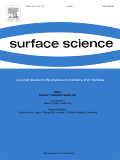
SURFACE SCIENCE
Scope & Guideline
Bridging Disciplines in Condensed Matter Physics
Introduction
Aims and Scopes
- Surface Chemistry and Catalysis:
Research focusing on the chemical processes occurring at surfaces, including catalysis, adsorption, and desorption phenomena. This area often includes studies on the mechanisms of catalysis and the design of catalytic materials. - Nanostructured Materials and Interfaces:
Investigation of materials at the nanoscale, including the synthesis, characterization, and application of nanostructured materials such as quantum dots, nanowires, and thin films, with a particular focus on their interfaces. - Photocatalytic and Electrocatalytic Processes:
Exploration of materials and systems that facilitate photocatalytic or electrocatalytic reactions, particularly for environmental remediation, energy conversion, and storage applications. - Thin Film Technologies:
Studies related to the deposition, characterization, and application of thin films, including their structural, optical, and electronic properties. - Surface Modification Techniques:
Research addressing various surface modification strategies to enhance the properties of materials, including coatings, doping, and functionalization. - Tribology and Wear Mechanisms:
Analysis of friction, wear, and lubrication at surfaces, focusing on the mechanisms that govern these phenomena in various materials and systems.
Trending and Emerging
- Sustainable and Green Chemistry:
A growing trend towards environmentally friendly materials and processes, with research focusing on sustainable synthesis, waste reduction, and the development of biodegradable materials. - 2D Materials and Heterostructures:
Significant interest in two-dimensional materials (like graphene and transition metal dichalcogenides) and their heterostructures, driven by their unique electronic, optical, and mechanical properties. - Advanced Photocatalysts for Environmental Remediation:
Increased research into novel photocatalytic materials designed for efficient degradation of pollutants and CO2 reduction, especially those involving hybrid systems and metal-organic frameworks. - Machine Learning and AI in Surface Science:
The incorporation of machine learning and artificial intelligence to predict material properties, optimize synthesis conditions, and analyze complex datasets is on the rise. - Interface Engineering:
A focus on the engineering of interfaces in materials to enhance performance in applications such as batteries, catalysis, and electronic devices, indicating a shift towards understanding and controlling interfacial phenomena.
Declining or Waning
- Traditional Surface Analysis Techniques:
There has been a noticeable decline in the emphasis on conventional surface analysis methods such as X-ray photoelectron spectroscopy (XPS) and atomic force microscopy (AFM), as researchers increasingly turn to more advanced and integrated techniques. - Bulk Material Studies:
The focus on bulk properties of materials is waning, with a shift towards surface and interface phenomena. This transition reflects the recognition that surface properties play a crucial role in determining the overall behavior of materials. - Static Surface Properties:
Research focused solely on static properties of surfaces, such as surface roughness and static contact angles, is becoming less prominent as dynamic and time-dependent phenomena gain attention.
Similar Journals
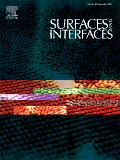
Surfaces and Interfaces
Pioneering Research in Surface and Coating TechnologiesSurfaces and Interfaces is a leading international journal published by Elsevier, dedicated to advancing the understanding of surface and interfacial phenomena across various disciplines, including chemistry, materials science, and physics. With an impressive impact factor placing it in the Q1 quartile for its categories as of 2023—spanning Chemistry, Condensed Matter Physics, and Surfaces, Coatings, and Films—this journal not only serves as a critical platform for innovative research but also reflects the dynamic nature of surface science in contemporary applications. The journal is indexed in Scopus, ranking 25th out of 132 in the Materials Science – Surfaces, Coatings and Films category, marking it in the top 19% of this prestigious field. Although it is not an open-access platform, the journal remains a vital source of curated academic material for researchers, professionals, and students seeking to deepen their knowledge and contribute to ongoing conversations in surface and interface science. Published from the heart of Europe in Amsterdam, Surfaces and Interfaces invites submissions that challenge conventional paradigms and explore the forefront of technology and materials.

Journal of Physical Chemistry Letters
Fostering Rapid Dissemination of Groundbreaking FindingsThe Journal of Physical Chemistry Letters, published by the American Chemical Society, is a premier journal in the fields of Physical and Theoretical Chemistry, Materials Science, and Nanoscience and Nanotechnology. Since its inception in 2010, this journal has established itself as a significant platform for rapid publications of cutting-edge research that bridges various branches of chemistry, providing a critical avenue for advancing knowledge in these dynamic fields. With an impressive impact factor and a consistent ranking in the top quartile (Q1) of its categories, the journal ranks 25th out of 189 in Physical and Theoretical Chemistry and 79th out of 463 in General Materials Science according to Scopus metrics. Although it currently does not operate under an open access model, it remains an essential resource for academics seeking to disseminate their findings to a global audience. Researchers, professionals, and students alike will find invaluable insights and contributions that push the boundaries of scientific inquiry within these disciplines.
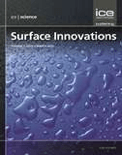
Surface Innovations
Connecting Scientists for Groundbreaking DiscoveriesSurface Innovations, an esteemed journal published by Emerald Group Publishing Ltd, serves as a crucial platform for researchers and professionals working within the fields of Materials Chemistry, Process Chemistry and Technology, and Surfaces, Coatings and Films. Launched in 2013, this journal has garnered attention for its commitment to advancing knowledge and innovation, holding a distinguished Q3 ranking in multiple categories as of 2023. With a focus on the latest methodologies and applications in surface science, Surface Innovations not only facilitates the dissemination of cutting-edge research but also encourages interdisciplinary collaboration among scientists and engineers. While not an open-access journal, it offers numerous options for accessibility to engage a wide array of audiences, making it a valuable resource for those looking to expand their understanding and expertise in this rapidly evolving field. The journal's consistent inclusion in high-ranking Scopus categories further underscores its academic impact and relevance.

Surface Topography-Metrology and Properties
Fostering collaboration in the realm of surface metrology and materials.Surface Topography-Metrology and Properties is an esteemed journal published by IOP Publishing Ltd, dedicated to advancing the field of surface metrology and its interrelation with material properties. With an ISSN of 2051-672X, this journal serves as a pivotal platform for researchers, professionals, and students engaged in the study of surfaces and coatings, particularly in disciplines such as Instrumentation, Materials Chemistry, and Process Chemistry and Technology. The journal maintains a strong academic presence with notable Category Quartile rankings, including Q2 in Materials Chemistry and Surfaces, Coatings and Films, and Q3 in other relevant fields. Although the journal operates under a subscription model, it offers valuable insights and findings that are crucial for advancing technologies reliant on surface characteristics and functionalities. Since its inception in 2013, the journal has continued to publish high-quality research up to the present day, catering to the ongoing needs of the scientific community and contributing significantly to the discourse in surface science.
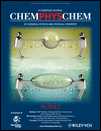
CHEMPHYSCHEM
Fostering High-Impact Discoveries in Theoretical and Experimental ScienceCHEMPHYSCHEM, published by WILEY-V C H VERLAG GMBH in Germany, stands as a pivotal resource for researchers and professionals in the fields of Atomic and Molecular Physics, as well as Physical and Theoretical Chemistry. With a commendable impact across its converged years from 2000 to 2024, the journal is categorized in the second quartile (Q2) for both aforementioned fields according to the 2023 metrics, underscoring its significance in advancing scientific dialogue and research. CHEMPHYSCHEM is committed to disseminating high-quality, peer-reviewed research articles that delve into the intricate interplay between chemistry and physics, making it an essential read for students and experts alike. The journal does not currently offer open access options, allowing for focused scholarly discussions that cater to the academic community's needs. As reflected in its Scopus rankings, CHEMPHYSCHEM maintains respectable standings, ranking #84/224 and #90/189 in its respective categories, demonstrating its commitment to high-impact research and innovation.

Protection of Metals and Physical Chemistry of Surfaces
Innovative Insights into Materials and CoatingsProtection of Metals and Physical Chemistry of Surfaces is a prominent academic journal published by MAIK NAUKA/INTERPERIODICA/SPRINGER, which provides a specialized platform for researchers and professionals in the fields of materials chemistry, metals and alloys, organic chemistry, as well as surfaces, coatings, and films. With an ISSN of 2070-2051 and an E-ISSN of 2070-206X, the journal is recognized for its rigorous peer-reviewed content and comprehensive coverage of innovative research addressing the latest advancements in material protection and surface chemistry. As of 2023, the journal has been categorized in the Q3 quartile across several relevant fields, highlighting its increasing influence within the scientific community. Although the journal is relatively niche, its open access model encourages wide dissemination of knowledge, fostering collaboration and advancements within its core disciplines. Research published in this journal plays a crucial role in not only enhancing theoretical understanding but also facilitating practical applications in various industries, thereby underlining its importance for students, researchers, and professionals alike.
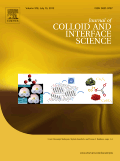
JOURNAL OF COLLOID AND INTERFACE SCIENCE
Exploring Innovations in Surface Chemistry and BiomaterialsJOURNAL OF COLLOID AND INTERFACE SCIENCE, published by Academic Press Inc, Elsevier Science, is a premier peer-reviewed journal that has been a cornerstone in the fields of colloid, surface chemistry, and biomaterials since its inception in 1966. With a strong impact in its respective disciplines, the journal holds a prestigious status in quartile rankings, including Q1 in Biomaterials, Colloid and Surface Chemistry, Electronic, Optical and Magnetic Materials, as well as Surfaces, Coatings, and Films for 2023. Its outstanding Scopus rankings, such as #4 in Colloid and Surface Chemistry and #6 in Surfaces, Coatings and Films, highlight its vital role in advancing research and understanding in these cutting-edge areas. Although not an open-access journal, it provides valuable insights and advancements that cater to an audience of researchers, professionals, and students aiming to push the boundaries of material science. As it continues to publish high-quality research through 2025 and beyond, the journal remains an essential resource for those involved in the exploration of the interactions between particles and surfaces.
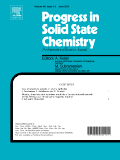
PROGRESS IN SOLID STATE CHEMISTRY
Unveiling Innovations in Materials SciencePROGRESS IN SOLID STATE CHEMISTRY, published by PERGAMON-ELSEVIER SCIENCE LTD, serves as a pivotal platform for disseminating cutting-edge research and advancements in the field of solid state chemistry. With an impressive impact factor and a respected status, this journal consistently ranks in the Q1 category across multiple disciplines, including Condensed Matter Physics, Materials Science, and Physical and Theoretical Chemistry. Following a rigorous peer-review process, it features articles that explore theoretical frameworks and experimental findings, thereby fostering innovation and collaboration among researchers and professionals. Although it does not adopt an open access model, its substantial reach and high Scopus rankings—19th in Condensed Matter Physics, 14th in Physical and Theoretical Chemistry, and 48th in General Materials Science—underscore its influence in shaping the future of materials research. Established in 1964, the journal continues to contribute significantly to the academic community, bridging the gap between theory and practical application in solid state materials.

Journal of the American Chemical Society
Catalyzing Innovation in Chemical ScienceJournal of the American Chemical Society (JACS), published by the American Chemical Society, stands as a pivotal publication in the field of chemistry, facilitating the dissemination of significant research findings since its inception in 1879. With an impressive impact factor and esteemed rankings placing it in the Q1 quartile across various categories—including Biochemistry, Catalysis, and Colloid and Surface Chemistry—JACS continues to serve as a vital resource for scientists, professionals, and students alike. Researchers choose JACS for its rigorous peer-review process, ensuring high-quality content that shapes the landscape of modern chemistry. The journal's extensive scope encompasses pivotal advancements and innovative methodologies, reflecting the evolving dynamics of chemical research. With access options being traditional subscription-based, it remains crucial for institutions and individuals to engage with its latest issues to stay at the forefront of chemical science advancement.

APPLIED SURFACE SCIENCE
Advancing the Frontiers of Surface ScienceApplied Surface Science is a premier international journal published by Elsevier, focusing on the critical advancements in surface and interface science since its inception in 1984. With an impressive impact factor that places it in the Q1 category across multiple disciplines such as chemistry, condensed matter physics, and materials science, this journal serves as an essential platform for researchers and professionals eager to disseminate their findings and explore innovative applications within the realm of surfaces, coatings, and films. The journal's scope includes, but is not limited to, the study of surface modification, nanostructuring, and the fabrication of advanced materials, making it pivotal for those seeking to push the boundaries of applied sciences. It rates highly in Scopus rankings, standing at Rank #22 in condensed matter physics, Rank #5 in surfaces and interfaces, and Rank #13 in surfaces, coatings, and films, underscoring its vital contribution to the scientific community. While open access options are not available, the journal remains a significant resource for academics and industry experts alike, fostering a deeper understanding of surface phenomena and their applications in various technological fields.